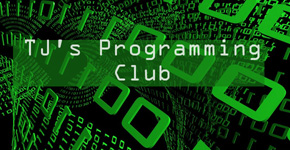TJ’s Programming Club sets a high standard for other Spartan groups.

TJ's programming club allows for students with similar interests to share their programming knowledge. Artwork by Tori Wallace
How many people would want to spend their free time after school writing computer code? All the members of Thomas Jefferson’s Programming Club do. In fact, some students just can’t get enough of programming in CCT Software Engineering class, thus creating a group for soaking in as much time writing computer code as possible.
The fresh club booted-up their inaugural meeting on Thursday, September 27th. They meet every Thursday after school in Teacher Stacey Fornstrom’s CCT classroom. These computer savvy students’ primary objective is to create programs through the application of C++ programming language, while teaching each other and learning through online tutorials. Club President Louis Ship adds, “We like to edit tester program files, modifying various codes to edit particular aspects of the documents as well.” He continues, adding, “We change sample files…just for fun!”
The club’s basis sprung from a mere idea. After hearing from a past middle school teacher that the best way to learn is to teach, Ship said that he knew what he needed do. Heading up a club is not an easy feat, however. Ship teaches basic program coding for around 30 to 40 minutes at the start of each meeting to give students a grasp of the main concepts. The group then proceeds to work on individual projects with the gained fresh knowledge. “I really like getting the kick start that Louis provides with information to get going,” said sophomore, Matthew Lawlor.
The club of around twelve members includes freshmen to seniors, who are each at different levels and possess an assortment of unique abilities to contribute to the group. There are no requirements to join except a will to expand one’s knowledge of C++ coding. “You just have to know how to turn on a computer,” Ship laughs.
Group Sponsor and Programming Teacher, Stacey Fornstrom, says he was thrilled when Ship came to him asking if he would be willing to support the group. “It’s interesting to have a new student create a club at TJ. Everything about it so far has been motivated by the students,” Fornstrom cheerfully noted.
The key difference between Fornstrom’s computer programming classes and the club is the type of language used to write the code. Instead of the usual classroom setting of Visual Basic (VB) jargon, the club applies C++ as a much higher and more technical form of programming the technology.
VB is a less tedious, simpler compiler of numerous pieces of commands, while C++ is the raw, extensive and detailed language of programmer gurus. Visual Basic was one of the initial series in which program writing for the Windows system was made viable. In contrast, the older text of C++ dialogue is considered an intermediate level of statically typed, free form language, which includes many other domains of applications.
C++ Example: # include <iostream>
int main()
{
std::cout << “Hello, world!n”;
}
Visual Basic Example: Private Sub Form_Load()
MsgBox “Hello, World!”
End Sub
“The club eventually hopes to collaborate in making one big, complex, program in which everyone’s acquired skills will be employed,” said Fornstrom. “The students will later on in the year discuss ideas on what this should consist of, each putting forth suggestions of what the currently unknown project will incorporate,” added Ship.
Group members concur on their excitement for the year’s projects, and agree that they can’t wait for all the new coding practice the club offers.